lane assist HONDA PILOT 2016 3.G User Guide
[x] Cancel search | Manufacturer: HONDA, Model Year: 2016, Model line: PILOT, Model: HONDA PILOT 2016 3.GPages: 661, PDF Size: 37.79 MB
Page 509 of 661
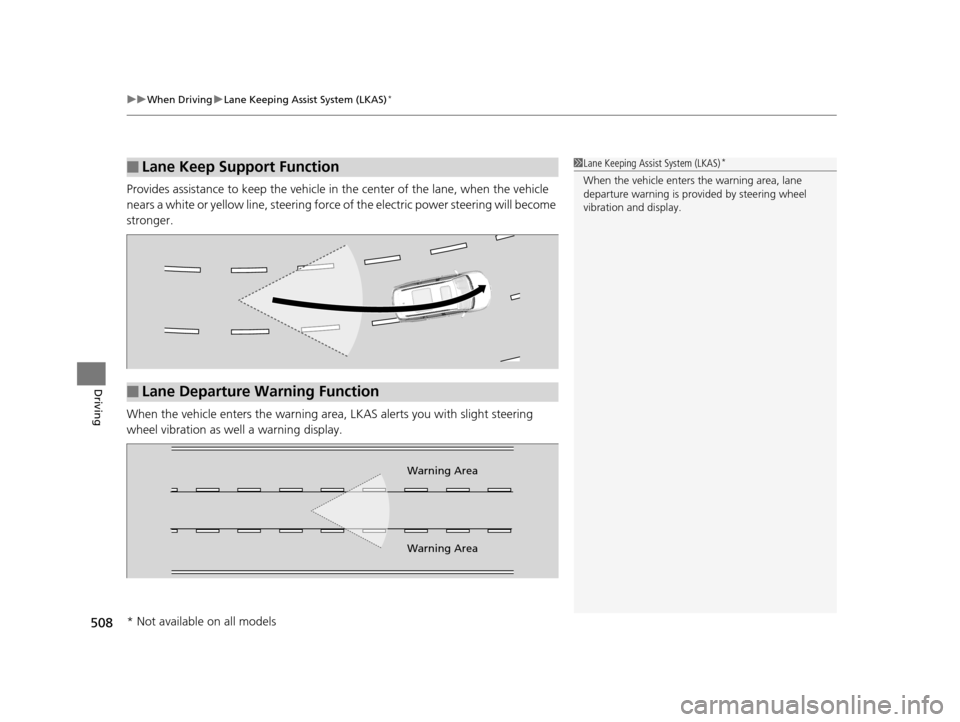
uuWhen Driving uLane Keeping Assist System (LKAS)*
508
Driving
Provides assistance to keep the vehicle in the center of the lane, when the vehicle
nears a white or yellow line, steering force of the electric power steering will become
stronger.
When the vehicle enters th e warning area, LKAS alerts you with slight steering
wheel vibration as we ll a warning display.
■Lane Keep Support Function1Lane Keeping Assist System (LKAS)*
When the vehicle enters the warning area, lane
departure warning is prov ided by steering wheel
vibration and display.
■Lane Departure Warning Function
Warning Area
Warning Area
* Not available on all models
16 PILOT-31TG76000.book 508 ページ 2015年6月15日 月曜日 午前11時30分
Page 510 of 661
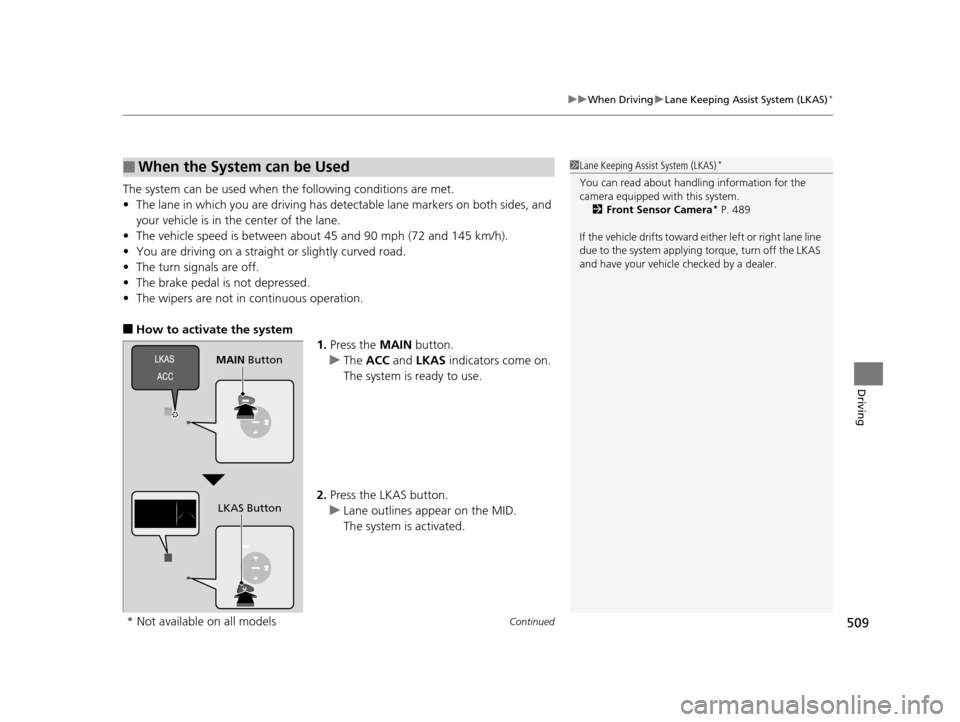
Continued509
uuWhen Driving uLane Keeping Assist System (LKAS)*
Driving
The system can be used when th e following conditions are met.
• The lane in which you are driving has detectable lane markers on both sides, and
your vehicle is in the center of the lane.
• The vehicle speed is between about 45 and 90 mph (72 and 145 km/h).
• You are driving on a straight or slightly curved road.
• The turn signals are off.
• The brake pedal is not depressed.
• The wipers are not in continuous operation.
■How to activate the system
1.Press the MAIN button.
u The ACC and LKAS indicators come on.
The system is ready to use.
2. Press the LKAS button.
u Lane outlines appear on the MID.
The system is activated.
■When the System can be Used1Lane Keeping Assist System (LKAS)*
You can read about handling information for the
camera equipped with this system.
2 Front Sensor Camera
* P. 489
If the vehicle drifts toward ei ther left or right lane line
due to the system applying torque, turn off the LKAS
and have your vehicle checked by a dealer.
MAIN Button
LKAS Button
* Not available on all models
16 PILOT-31TG76000.book 509 ページ 2015年6月15日 月曜日 午前11時30分
Page 511 of 661
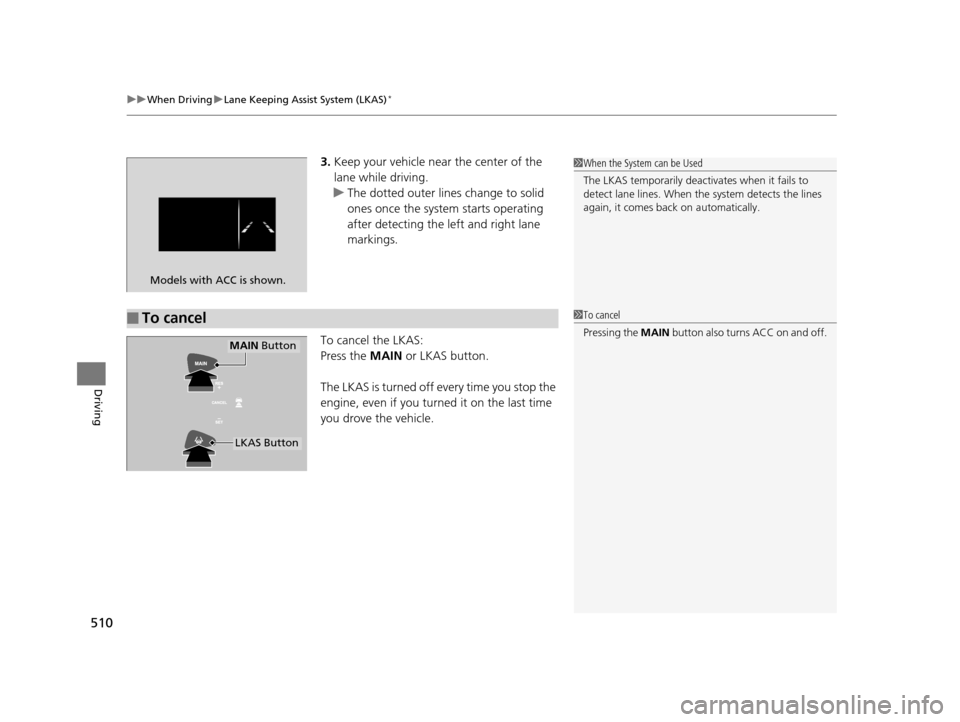
uuWhen Driving uLane Keeping Assist System (LKAS)*
510
Driving
3. Keep your vehicle near the center of the
lane while driving.
u The dotted outer lines change to solid
ones once the system starts operating
after detecting the left and right lane
markings.
To cancel the LKAS:
Press the MAIN or LKAS button.
The LKAS is turned off every time you stop the
engine, even if you turned it on the last time
you drove the vehicle.
Models with ACC is shown.
■To cancel
1 When the System can be Used
The LKAS temporarily deactivates when it fails to
detect lane lines. When the system detects the lines
again, it comes back on automatically.
1To cancel
Pressing the MAIN button also turns ACC on and off.
MAIN Button
LKAS Button
16 PILOT-31TG76000.book 510 ページ 2015年6月15日 月曜日 午前11時30分
Page 512 of 661
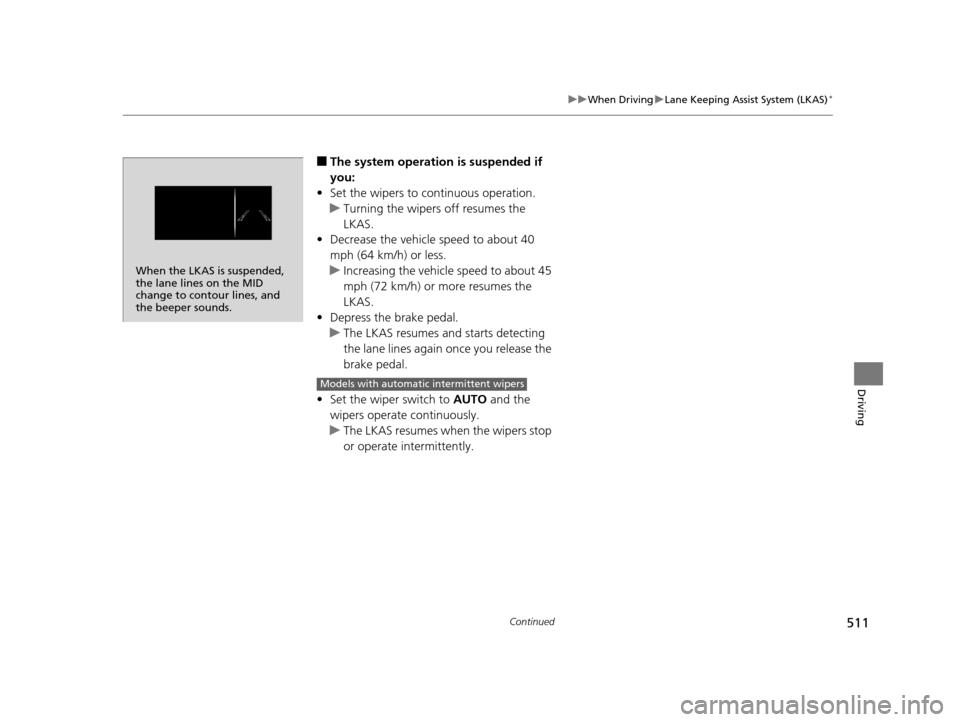
511
uuWhen Driving uLane Keeping Assist System (LKAS)*
Continued
Driving
■The system operation is suspended if
you:
• Set the wipers to continuous operation.
u Turning the wipers off resumes the
LKAS.
• Decrease the vehicle speed to about 40
mph (64 km/h) or less.
u Increasing the vehicle speed to about 45
mph (72 km/h) or more resumes the
LKAS.
• Depress the brake pedal.
u The LKAS resumes and starts detecting
the lane lines again once you release the
brake pedal.
• Set the wiper switch to AUTO and the
wipers operate continuously.
u The LKAS resumes when the wipers stop
or operate intermittently.
When the LKAS is suspended,
the lane lines on the MID
change to contour lines, and
the beeper sounds.
Models with automatic intermittent wipers
16 PILOT-31TG76000.book 511 ページ 2015年6月15日 月曜日 午前11時30分
Page 513 of 661
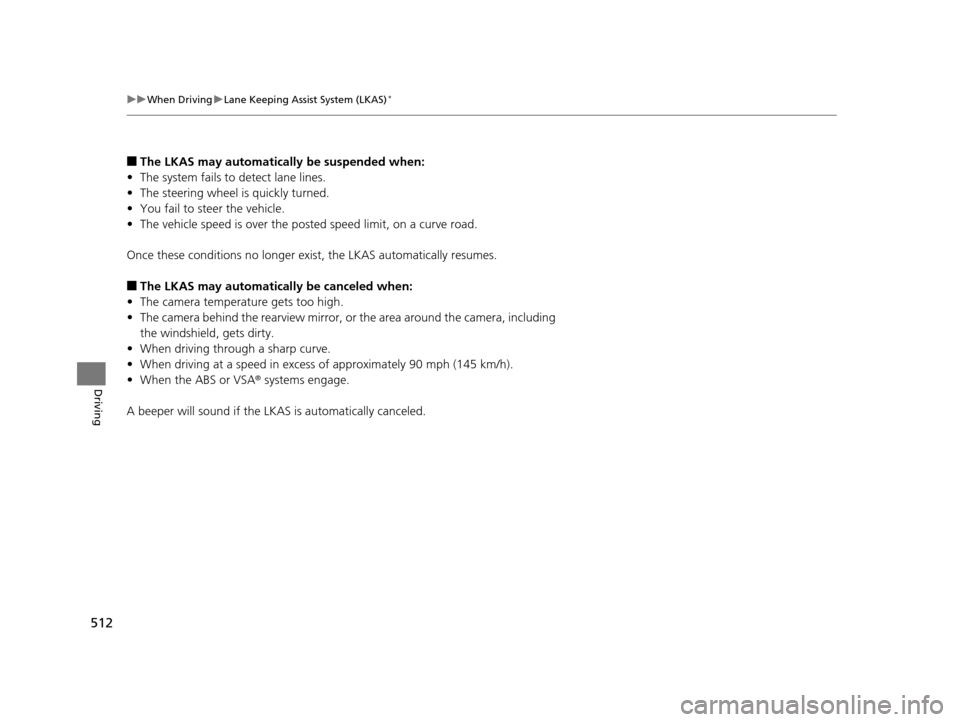
512
uuWhen Driving uLane Keeping Assist System (LKAS)*
Driving
■The LKAS may automatically be suspended when:
• The system fails to detect lane lines.
• The steering wheel is quickly turned.
• You fail to steer the vehicle.
• The vehicle speed is over the pos ted speed limit, on a curve road.
Once these conditions no longer exis t, the LKAS automatically resumes.
■The LKAS may automatically be canceled when:
• The camera temperature gets too high.
• The camera behind the rearview mirror, or the area around the camera, including
the windshield, gets dirty.
• When driving through a sharp curve.
• When driving at a speed in excess of approximately 90 mph (145 km/h).
• When the ABS or VSA ® systems engage.
A beeper will sound if the LKAS is automatically canceled.
16 PILOT-31TG76000.book 512 ページ 2015年6月15日 月曜日 午前11時30分
Page 514 of 661
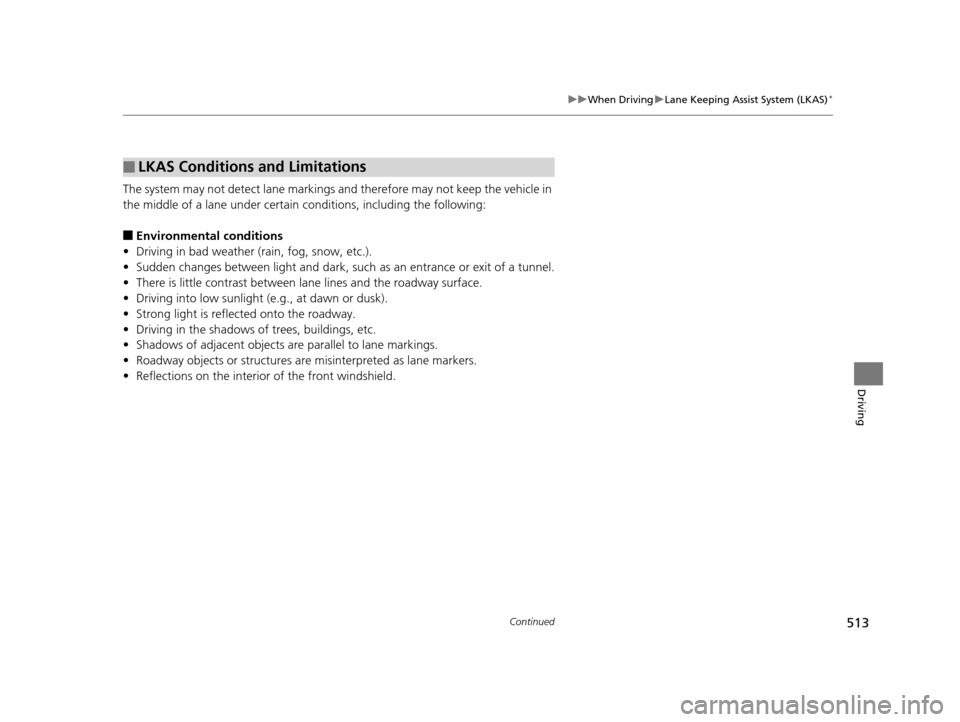
513
uuWhen Driving uLane Keeping Assist System (LKAS)*
Continued
Driving
The system may not detect lane markings and therefore may not keep the vehicle in
the middle of a lane under certain conditions, including the following:
■Environmental conditions
• Driving in bad weather (rain, fog, snow, etc.).
• Sudden changes between light and dark, such as an entrance or exit of a tunnel.
• There is little contrast between lane lines and the roadway surface.
• Driving into low sunlight (e.g., at dawn or dusk).
• Strong light is reflec ted onto the roadway.
• Driving in the shadows of trees, buildings, etc.
• Shadows of adjacent objects are parallel to lane markings.
• Roadway objects or structures are misinterpreted as lane markers.
• Reflections on the interior of the front windshield.
■LKAS Conditions and Limitations
16 PILOT-31TG76000.book 513 ページ 2015年6月15日 月曜日 午前11時30分
Page 515 of 661
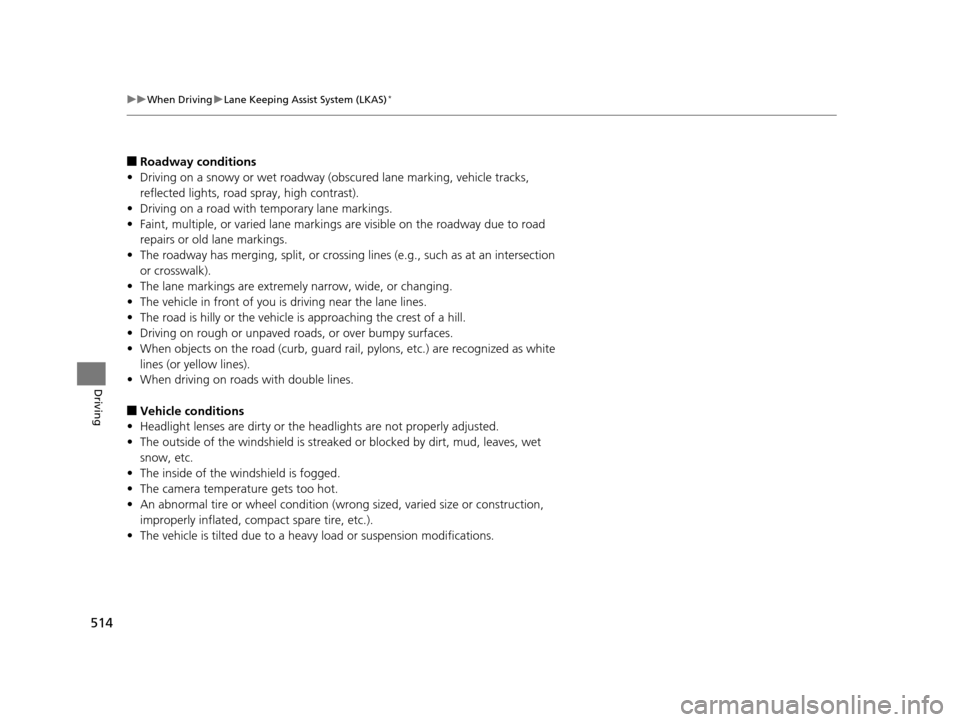
514
uuWhen Driving uLane Keeping Assist System (LKAS)*
Driving
■Roadway conditions
• Driving on a snowy or wet roadway (obscured lane marking, vehicle tracks,
reflected lights, road spray, high contrast).
• Driving on a road with temporary lane markings.
• Faint, multiple, or varied lane markings are visible on the roadway due to road
repairs or old lane markings.
• The roadway has merging, split, or crossing lines (e.g., such as at an intersection
or crosswalk).
• The lane markings are extremely narrow, wide, or changing.
• The vehicle in front of you is driving near the lane lines.
• The road is hilly or the vehicle is approaching the crest of a hill.
• Driving on rough or unpaved roads, or over bumpy surfaces.
• When objects on the road (c urb, guard rail, pylons, etc.) are recognized as white
lines (or yellow lines).
• When driving on roads with double lines.
■Vehicle conditions
• Headlight lenses are dirty or the headlights are not properly adjusted.
• The outside of the windshield is streake d or blocked by dirt, mud, leaves, wet
snow, etc.
• The inside of the windshield is fogged.
• The camera temperature gets too hot.
• An abnormal tire or wheel condition (wrong sized, varied size or construction,
improperly inflated, comp act spare tire, etc.).
• The vehicle is tilted due to a heav y load or suspension modifications.
16 PILOT-31TG76000.book 514 ページ 2015年6月15日 月曜日 午前11時30分
Page 519 of 661
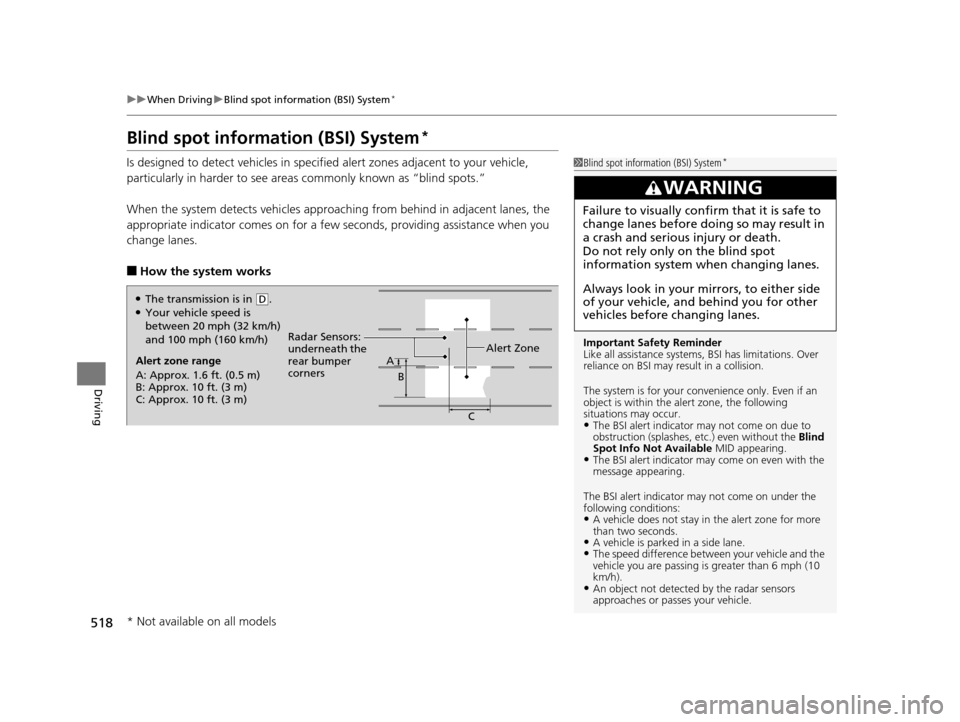
518
uuWhen Driving uBlind spot information (BSI) System*
Driving
Blind spot information (BSI) System*
Is designed to detect vehicl es in specified alert zones adjacent to your vehicle,
particularly in harder to see areas commonly known as “blind spots.”
When the system detects vehi cles approaching from behind in adjacent lanes, the
appropriate indicator comes on for a few se conds, providing assistance when you
change lanes.
■How the system works
1 Blind spot inform ation (BSI) System*
Important Safety Reminder
Like all assistance systems, BSI has limitations. Over
reliance on BSI may result in a collision.
The system is for your convenience only. Even if an
object is within the alert zone, the following
situations may occur.
•The BSI alert indicator may not come on due to
obstruction (splashes, et c.) even without the Blind
Spot Info Not Available MID appearing.
•The BSI alert indicator may come on even with the
message appearing.
The BSI alert i ndicator may not come on under the
following conditions:
•A vehicle does not stay in the alert zone for more
than two seconds.
•A vehicle is parked in a side lane.•The speed difference betw een your vehicle and the
vehicle you are passing is greater than 6 mph (10
km/h).
•An object not detected by the radar sensors
approaches or passes your vehicle.
3WARNING
Failure to visually confirm that it is safe to
change lanes before doing so may result in
a crash and serious injury or death.
Do not rely only on the blind spot
information system wh en changing lanes.
Always look in your mirrors, to either side
of your vehicle, and behind you for other
vehicles before changing lanes.
Alert zone range
A: Approx. 1.6 ft. (0.5 m)
B: Approx. 10 ft. (3 m)
C: Approx. 10 ft. (3 m) Radar Sensors:
underneath the
rear bumper
corners
Alert ZoneA
B
C
●The transmission is in (D.●Your vehicle speed is
between 20 mph (32 km/h)
and 100 mph (160 km/h)
* Not available on all models
16 PILOT-31TG76000.book 518 ページ 2015年6月15日 月曜日 午前11時30分
Page 521 of 661
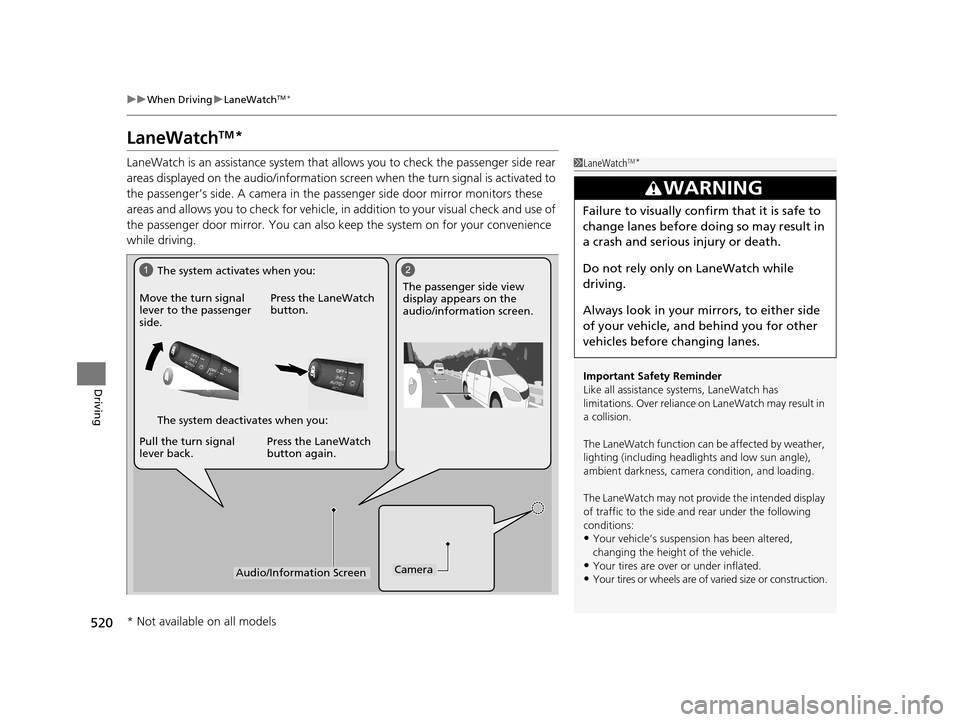
520
uuWhen Driving uLaneWatchTM*
Driving
LaneWatchTM*
LaneWatch is an assistance system that allows you to check the passenger side rear
areas displayed on the audio/in formation screen when the turn signal is activated to
the passenger’s side. A camera in the passenger side door mirror monitors these
areas and allows you to check for vehicle, in addition to your visual check and use of
the passenger door mirror. You can also keep the system on for your convenience
while driving.1 LaneWatchTM*
Important Safety Reminder
Like all assistance systems, LaneWatch has
limitations. Over reliance on LaneWatch may result in
a collision.
The LaneWatch func tion can be affected by weather,
lighting (including headli ghts and low sun angle),
ambient darkness, camera condition, and loading.
The LaneWatch may not prov ide the intended display
of traffic to the side and rear under the following
conditions:
•Your vehicle’s suspension has been altered,
changing the height of the vehicle.
•Your tires are over or under inflated.
•Your tires or wheels are of varied size or construction.
3WARNING
Failure to visually confirm that it is safe to
change lanes before doing so may result in
a crash and serious injury or death.
Do not rely only on LaneWatch while
driving.
Always look in your mirrors, to either side
of your vehicle, and behind you for other
vehicles before changing lanes.
12
CameraAudio/Information Screen
Move the turn signal
lever to the passenger
side.
Press the LaneWatch
button.
Pull the turn signal
lever back. Press the LaneWatch
button again. The passenger side view
display appears on the
audio/information screen.
The system activates when you:
The system deactivates when you:
* Not available on all models
16 PILOT-31TG76000.book 520 ページ 2015年6月15日 月曜日 午前11時30分
Page 654 of 661
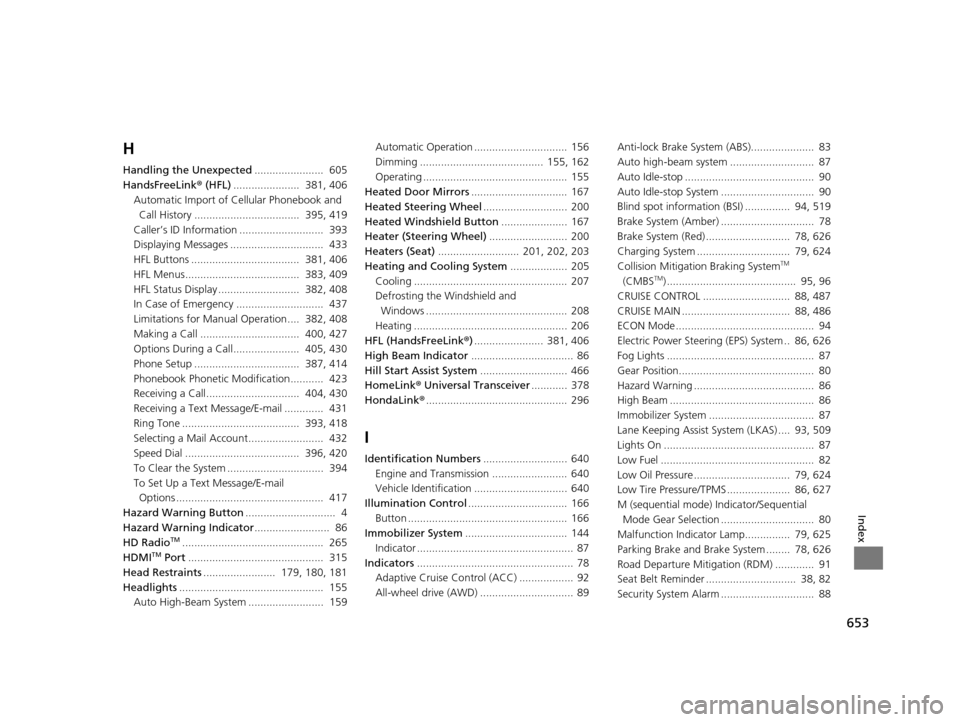
653
Index
H
Handling the Unexpected....................... 605
HandsFreeLink ® (HFL) ...................... 381, 406
Automatic Import of Cellular Phonebook and Call History ................................... 395, 419
Caller’s ID Information ............................ 393
Displaying Messages ............................... 433
HFL Buttons .................................... 381, 406
HFL Menus...................................... 383, 409
HFL Status Display ........................... 382, 408
In Case of Emergency ............................. 437
Limitations for Manual Operation.... 382, 408
Making a Call ................................. 400, 427
Options During a Call...................... 405, 430
Phone Setup ................................... 387, 414
Phonebook Phonetic Modification........... 423
Receiving a Call............................... 404, 430
Receiving a Text Message/E-mail ............. 431
Ring Tone ....................................... 393, 418
Selecting a Mail Account......................... 432
Speed Dial ...................................... 396, 420
To Clear the System ................................ 394
To Set Up a Text Message/E-mail Options ................................................. 417
Hazard Warning Button .............................. 4
Hazard Warning Indicator ......................... 86
HD Radio
TM............................................... 265
HDMITM Port ............................................. 315
Head Restraints ........................ 179, 180, 181
Headlights ................................................ 155
Auto High-Beam System ......................... 159 Automatic Operation ............................... 156
Dimming ......................................... 155, 162
Operating ................................................ 155
Heated Door Mirrors ................................ 167
Heated Steering Wheel ............................ 200
Heated Windshield Button ...................... 167
Heater (Steering Wheel) .......................... 200
Heaters (Seat) ........................... 201, 202, 203
Heating and Cooling System ................... 205
Cooling ................................................... 207
Defrosting the Windshield and
Windows ............................................... 208
Heating ................................................... 206
HFL (HandsFreeLink ®)....................... 381, 406
High Beam Indicator .................................. 86
Hill Start Assist System ............................. 466
HomeLink® Universal Transceiver ............ 378
HondaLink® ............................................... 296
I
Identification Numbers ............................ 640
Engine and Transmission ......................... 640
Vehicle Identification ............................... 640
Illumination Control ................................. 166
Button ..................................................... 166
Immobilizer System .................................. 144
Indicator .................................................... 87
Indicators .................................................... 78
Adaptive Cruise Control (ACC) .................. 92
All-wheel drive (AWD) ............................... 89 Anti-lock Brake System (ABS)..................... 83
Auto high-beam system ............................ 87
Auto Idle-stop ........................................... 90
Auto Idle-stop System ............................... 90
Blind spot information (BSI) ............... 94, 519
Brake System (Amber) ............................... 78
Brake System (Red) ............................ 78, 626
Charging System ............................... 79, 624
Collision Mitigati
on Braking System
TM
(CMBSTM) ........................................... 95, 96
CRUISE CONTROL ............................. 88, 487
CRUISE MAIN .................................... 88, 486
ECON Mode .............................................. 94
Electric Power Steering (EPS) System .. 86, 626
Fog Lights ................................................. 87
Gear Position............................................. 80
Hazard Warning ........................................ 86
High Beam ................................................ 86
Immobilizer System ................................... 87
Lane Keeping Assist System (LKAS) .... 93, 509
Lights On .................................................. 87
Low Fuel ................................................... 82
Low Oil Pressure ................................ 79, 624
Low Tire Pressure/TPMS ..................... 86, 627
M (sequential mode) I ndicator/Sequential
Mode Gear Selection ............................... 80
Malfunction Indicator Lamp............... 79, 625
Parking Brake and Brake System ........ 78, 626
Road Departure Mitigation (RDM) ............. 91
Seat Belt Reminder .............................. 38, 82
Security System Alarm ............................... 88
16 PILOT-31TG76000.book 653 ページ 2015年6月15日 月曜日 午前11時30分